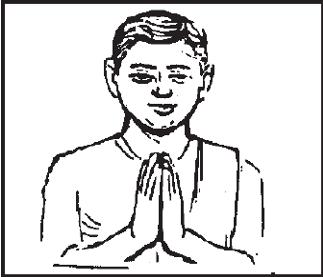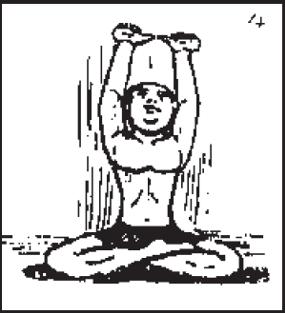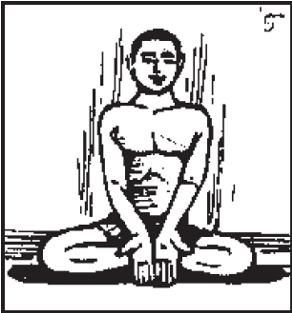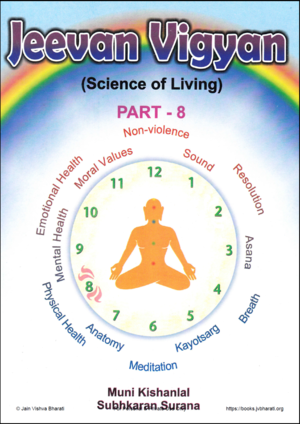
A thought is an event of the mind. Expression of a thought is projected on human body in the form of various facial expressions. These are called Postures. Postures reflect thoughts. A posture is an end result of a thought. As the postures are assumed some kind of thoughts find expression in them. Letters of alphabet are symbols of various thoughts. Letters make words and words form sentences. From sentences we get languages. Publication of a book in any language is nothing but an expression of thoughts. In the same way, body postures express thoughts prevailing within the mind. In the concept of Jeevan Vigyan, we can practice postures in order to generate positive thoughts. These positive thoughts can accomplish the formulation of a desired character.
The only aim of students is to receive education. Education in the form of instruction is received from venerated teachers. There is a saying in Sanskrit that education teaches the student to be humble. Humility in turn again enables him to acquire more knowledge. Those students who desire to achieve distinctive capabilities in the field of education, must practice respectful Posture of Greetings. There are five variations of posture of respectful greetings:
- Arham Posture (for the Capable)
- Siddha Posture (for the Proficient)
- Acharya Posture (for the Professor)
- Upadhyaya Posture (for the Lecturer)
- Muni Posture (for the Sage)
The essence of the Arham Mudra is in acquiring capability which is secured by reaching the highest level of knowledge. At this level one tends towards being an ascetic.
The essence of the Siddha Mudra is total freedom from all kinds of bondage. The essence of Acharya Mudra is veneration and dedication. The essence of the Upadhyaya Mudra is study and concentration. The essence of the Muni Mudra is equity and Sadhana. All these postures can help students to fulfil their aims.

PROCEDURE TO ASSUME THESE POSTURES
1. ARHAM MUDRA:
PROCEDURE:
Choose either Sukhasana or Padmasana. In case of Sukhasana the left foot may be placed under the right thigh. The right foot is to be placed under the left thigh. Be static in the position of Sukhasana. Bring both palms in the centre of the chest and join them in the position of Namaskar.
Now inhale and take both hands up over the top of head. Arms would be touching the ears. Now exhale and retaining the palms in the Namaskar position bring them back to the center of the left heart (Anand Kendra).
ADVANTAGES:
Arham posture helps one to be delivered from infatuation. One's view-point is liberated from the bondage of likes and dislikes. It is the fountainhead of all capabilities one would like to acquire. From the physical point of view fingers, palms, writs, fore-arms, elbows and shoulders become robust. Stomach, chest, ribs and spine are activated. Secretions by the thymus gland become regulated. Brain gets developed. Secretions by the adrenal glands help one to achieve his or her aims when they are regulated by this posture.
2. SIDDHA MUDRA:
PROCEDURE:
Established firmly in the Sukhasana or Padmasana. Fold your hands in the Namaskar Mudra in front and at the center of the heart (Anand Kendra). Inhale and take your hands straight up, opening the palms at the top parallel to the ground. Arms will be touching to the ears. Visualize that eternal strength is entering your body.
Now exhale and closing the palms bring them back in the Namaskar Mudra at the center of the heart (Anand Kendra).
ADVATNAGES:
Muscles of hands, forearms and biceps become strong. In addition, secretions of adrenal and thymus glands are regulated. It helps in increasing alertness. The mind inclines towards high thinking. It develops abstinence.
3. ACHARYA MUDRA:
PROCEDURE:
Sit firmly in the Sukhasana or Padmasana. Bring both the palms in Namaskar Mudra at the centre of the heart (AnandKendra).
Now inhale and while opening the hands, bring them gradually to the shoulder level. Touch the shoulders ends with the thumbs, keeping the palms opened and straight. Now exhale and return to the Namaskar Mudra. This is Acharya Mudra.
ADVANTAGES:
This mudra inculcates immaculate traits of character Chest and lungs expand. This mudra regulate the flow of secretions by the thymus bringing about a joyous disposition.

4. UPADHYAYA MUDRA:
PROCEDURE:
Bring both the palms together in the Namaskar Mudra at the center of the heart remaining in the Sukhasana or Padmasana.
Inhale and take both palms straight up facing the sky. Arms are to be kept touching the ears. Both the thumbs should also touch each other. Tilt the head backward to enable to look at the sky without blinking the eyes. Now exhale and return to the Namaskar Mudra, bringing the head back in its natural position.
ADVANTAGES:
The Upadhyaya Mudra teaches one to be humble which is another name for greatness. This mudra regulates the flow of secretions by thyroid, parathyroid, pituitary, pineal and thymus glands. Pain in the neck region disappears. One can concentrate better on the studies. Eye-sight is improved and corrected.

5. MUNI MUDRA:
PROCEDURE:
Assume the position of the Sukhasana or Padmasana. Bring the palms together in the center of the chest in the Namaskar Mudra. Inhale and take both hands straight up and stop inhalation. Hold both hands into the Anjali Mudra (Dedication), displaying your veneration and devotion. Bring them down, touching the ground with fingertips, palms will remain open. Now return to the Namaskar Mudra position gradually, exhaling slowly.
ADVANTAGES:
The Muni Mudra generates the quality of veneration and devotion. Ego disappears from the nature of the person who devotedly performs this Muni Mudra. From the physical point of view the flow of secretions by the thymus gland becomes regulated. Mercy and amity flourish.
EXERCISE
- What is the importance of Mudras?
- What are the advantages of the Arham Mudra?
- What are the advantages of the Siddha Mudra?
- What are the advantages of the Acharya Mudra?
- What are the advantages of the Upaddhyaya Mudra?
- What are the advantages of the Muni Mudra?
